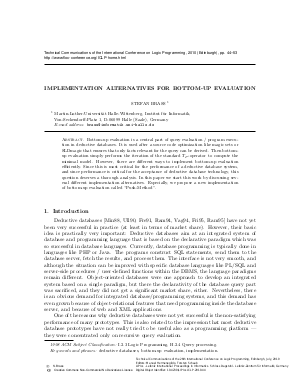Implementation Alternatives for Bottom-Up Evaluation
Author Stefan Brass
-
Part of:
Volume:
Technical Communications of the 26th International Conference on Logic Programming (ICLP 2010)
Part of: Series: Leibniz International Proceedings in Informatics (LIPIcs)
Part of: Conference: International Conference on Logic Programming (ICLP) - License:
 Creative Commons Attribution-NonCommercial-NoDerivs 3.0 Unported license
Creative Commons Attribution-NonCommercial-NoDerivs 3.0 Unported license
- Publication Date: 2010-06-25
File

PDF
LIPIcs.ICLP.2010.44.pdf
- Filesize: 263 kB
- 10 pages
Document Identifiers
Subject Classification
Keywords
- Deductive databases
- bottom-up evaluation
- implementation
Metrics
- Access Statistics
-
Total Accesses (updated on a weekly basis)
0PDF Downloads0Metadata Views
Abstract
Bottom-up evaluation is a central part of query evaluation / program execution in deductive databases. It is used after a source code optimization like magic sets or SLDmagic that ensures that only facts relevant for the query can be derived. Then bottom-up evaluation simply performs the iteration of the standard TP -operator to compute the minimal model. However, there are different ways to implement bottom-up evaluation efficiently. Since this is most critical for the performance of a deductive database system, and since performance is critical for the acceptance of deductive database technology, this question deserves a thorough analysis. In this paper we start this work by discussing several different implementation alternatives. Especially, we propose a new implementation of bottom-up evaluation called "Push-Method".
Cite As Get BibTex
Stefan Brass. Implementation Alternatives for Bottom-Up Evaluation. In Technical Communications of the 26th International Conference on Logic Programming. Leibniz International Proceedings in Informatics (LIPIcs), Volume 7, pp. 44-53, Schloss Dagstuhl – Leibniz-Zentrum für Informatik (2010)
https://doi.org/10.4230/LIPIcs.ICLP.2010.44
BibTex
@InProceedings{brass:LIPIcs.ICLP.2010.44,
author = {Brass, Stefan},
title = {{Implementation Alternatives for Bottom-Up Evaluation}},
booktitle = {Technical Communications of the 26th International Conference on Logic Programming},
pages = {44--53},
series = {Leibniz International Proceedings in Informatics (LIPIcs)},
ISBN = {978-3-939897-17-0},
ISSN = {1868-8969},
year = {2010},
volume = {7},
editor = {Hermenegildo, Manuel and Schaub, Torsten},
publisher = {Schloss Dagstuhl -- Leibniz-Zentrum f{\"u}r Informatik},
address = {Dagstuhl, Germany},
URL = {https://drops.dagstuhl.de/entities/document/10.4230/LIPIcs.ICLP.2010.44},
URN = {urn:nbn:de:0030-drops-25820},
doi = {10.4230/LIPIcs.ICLP.2010.44},
annote = {Keywords: Deductive databases, bottom-up evaluation, implementation}
}
